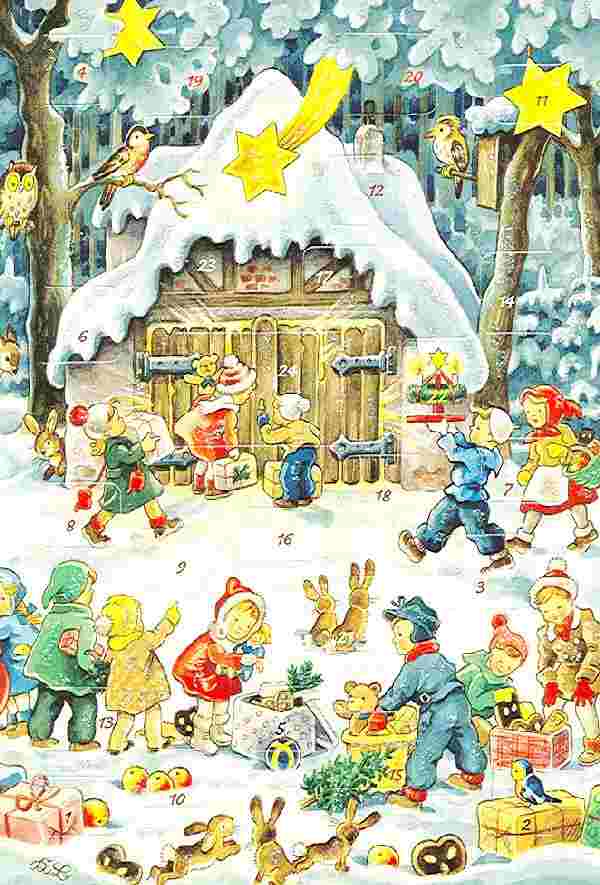

Christmas in Germany: Adventskalender

Figure 1.-- One charming German Christmas tradition is the Adventskalender. It is a special Christmas card for children. The card has 24 little windows which the child begins
opening on December 1. Each has aovely little drrawing behind it. Of course the last window is opened Christmast eve.
|
|
Here we have a charming German Advent Calandar that a HBC reader has sent us. We thought at first that this was a distincly German tradition, but our European readers tell us thjat they are popular in many European countries. We have not noted them in America, but one of our American readers tells us that she has seen them.
Advent
Advent in the Christmas tradition refers to the coming of Christ into the World. In Christian practice it is the penitential period covered by the four Sundaus before Christmas during which Christ's coming is celebrated.
The Calandars
The dates of Advent vary from year to year depending on thecday of the Week Christmas falls. To simplify matters, Advent calandars simply begin on December 1 and run through December 24 as is the case here (figure 1). It is a special Christmas card for children. The card has 24 little windows which the child begins
opening on December 1. Each has aovely little drrawing behind it. Of course the last window is opened Christmast eve. This gives a child something to open each day as suspense grows while Chrismas gets closer and closer. Many Advent Calandars like the one here is a grreeting card. Some are more like toys and large enough to old small toys or candies behinf each window.
Country Trends
We have noted trends with these Advent Calendars in different countries.
Germany
Here we see a German Christmas Adventskalender. This is a popular tradition in Germany. A German reader has sent us a sample card with a classic design, but there are many different styles
available. Advent of course is a Christian tradition, but there are Adventskalenders with no religious reference whatsoever. We believe that earlier Adventskalender had more of a religious connotation. Germany like much of Europe is becoming higly secular and this has also affected the Adventskalender tradition. Our reader notes that all German children are familiar with these cards and most receive one for Christmas. This seems a very clever holiday tradition. Our German reader writes, "The one I sent you is a card. But this is only one version of an Adventskalender!
There are so many forms that I can't describe all of the them. The can be very large and very tiny. They can have (mostly) chocolate behind the doors or other sweets. They can be self-made in every form or material. What makes them an Adventskalender is that there are just 24 things that can be opened. That's all! Even our cats have an Adventskalender with candy for cats in it. Luzie, our girl cat, don't likes it. She prefers other things to eat. But our tom-cat Jakob loves it and like a little child he can hardly wait when the next door is opened. Well, maybe this sounds rather silly to you. But my Mum lost a bet so she had to buy the Adventskalender.
In the shop for animal supply I also saw Adventskalenders for dogs and rabbits."
England
A British reader writes, "I have no idea of their origin but they are certainly still popular in the UK. I can remember both buying them and making them at (primary) school in the 1950s/early 1960s." Another English reader writes, "I too remember making advent calendars at primary school and seeing them for sale too.We used to go up to my grandparents in Leeds for Christmas and they always had one which had a chocolate behind each window (they were "Terry's" chocolates which was a firm from York which made expensive chocolates).We only got up there shortly before Christmas but none of the windows were opened yet but the three of us boys used to soon bring it "up to date".We were allowed one each after the evening meal if we'd eaten all of our other food and it was quite a treat as we weren't usually allowed a lot of chocolates and sweets at home.When it came to Christmas Day and my cousins were there too they'd get the chance to bring the calendar! fully up to date - but the last chocolate which was a special one was always reserved for my Mum."
France
This tradition is very popular also in France with the
same sort of card seen in Germany. Most French children receive cards like this. They open the first window on December 1 and the last on December 24. Behind these little windows they find a little figurine of chocolate. They are called a Calandrier de NoŽl. A French reader tells us, "My children every December recieved one."
I have never seen these cards offered here in America. A British reader writes, "I was surprised that you say they are unknown in the USA. The thought has since occurred to me that this may be connected with different religious attitudes towards Christmas (within Christianity) between Europe and America in
general. Advent calendars despite the name are usually not very religious. Much of what goes on at Christmas is quite traditional (and Catholic) and not very protestant/non-conformist. Just an undeveloped thought." It is probably not accurate to suggest that there is a single American attitude toward religion. It is true that America is much more reigious than Europe. America is, however, deeply divided as to religion. Many Americans probably about half of the country have a much more European secular outlook.
An American reader tells us, "I was surprised to read on your page that Advent Calenders are not used in the United States. They certainly were when I was growing up, and I have seen them in the stores this Christmas season. American Advent Calenders are frequently more complex than the ones described on your site. Instead of a card with pictures behind the door, the ones I see here in the US have a small box behind each door and in the box is a piece of candy or a small toy. There are some with
themes, where each door reveals a small christmas tree ornament. I have also seen fabric calenders-- with pockets instead of doors, and each pocket is numbered and contains a plush toy or tree ornament. Sometimes the toys also have a number on them, so eerything can be put back at the end of the season and used again the next year.
I see these calenders in one form or another nearly every year as I do my Christmas shopping." HBC was thinking more about greeting cards and we have not seen tem in the big mass-market chain stores. It does not surprise me that they exist in Ameriva, but I would be surprised if large numbers of American children receive them.
HBC

Navigate the Boys' Historical Clothing Web holiday pages:
[Return to the Main German Christmas page]
[New Years]
[Valetines]
[St. Patrick's Day]
[Easter]
[Fourth of July]
[Haloween]
[Thanksgiving]
[Christmas]
Navigate the Boys' Historical Clothing Web Site:
[Introduction]
[Activities]
[Biographies]
[Chronology]
[Clothing styles]
[Countries]
[Topics]
[Bibliographies]
[Contributions]
[FAQs]
[Glossaries]
[Satellite sites]
[Tools]
[Boys' Clothing Home]
Created: 5:54 AM 12/16/2004
Last updated: 5:12 PM 12/18/2004




